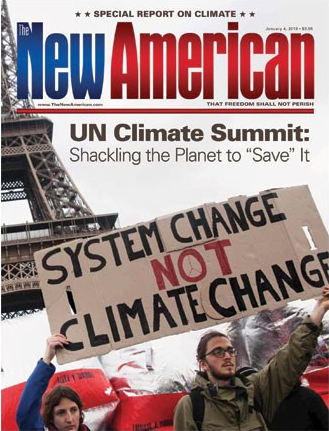
One of today’s popular boogeymen, along with “climate change,” is overpopulation. It was a boogeyman centuries ago, too. The English cleric and scholar Thomas Malthus warned in 1798, “The power of population is indefinitely greater than the power in the earth to produce subsistence for man.” Since then, the 1800 world population of one billion has risen to seven billion. And not surprisingly, the notion of an ever-burgeoning population as a clear and present danger has become a basic supposition, one creating perturbation and shaping policy.
On November 13, for instance, some celebrated “World Vasectomy Day” and held a “vasectomy-athon” in which men, many Western, trumpeted their newfound sterility. Precisely two weeks before, Bowdoin College associate professor of philosophy Sarah Conley, though doubtless a relativist, was quite absolutist in a Boston Globe op-ed entitled “Here’s why China’s one-child policy was a good thing.” Insisting “there is no moral right to have more than one child,” Conley wrings her hands as she warns that the “most recent estimate from the United Nations says we’ll reach a population of 9.7 billion by 2050” and justifies elimination of reproductive freedom by likening it to yelling “Fire!” in a crowded movie theater. It seems the rallying cry “My body, my choice!” only applies to killing children in the womb, not birthing them.
Population Implosion
It would be easy here to jump to how the professor is joining the ranks of universally poor prognosticators and why their predictions reflect divining-rod reliability, but first a simple fact must be recognized: Man does not face an impending population explosion.
We face a population implosion.
Contrary to popular myth and as illustrated well in the fine documentary Demographic Winter, countries with a fertility rate (FR) below replacement level (2.1 children per woman) now number more than 80 worldwide — and counting. This list includes the entire West, where populations whose ancestors birthed Western civilization are disappearing. As examples, know that My Big Fat Greek Wedding is a big fat Greek myth: The cradle of Western civilization now has empty cradles with an FR of 1.34; Italy, whose Roman ancestors assumed the Hellenistic mantle, has an FR of 1.4. The sun has also set on native Britons’ fecundity just as it did on their empire; the United Kingdom’s overall FR has risen to 1.98 due to Muslim baby-booming, but indigenous Britons’ FR is lower.
The same demographic reality is evident in most of Asia, with China (1.7), Japan (1.4), Hong Kong (1.2), Singapore (1.3), and South Korea (1.2) being prime examples. And many developing nations are on the same trajectory, with Costa Rica (1.9), Uruguay (1.9), Brazil (1.8), and Cuba (1.7) illustrating the point. Then there’s Mexico: While its women bore almost seven children each in the 1960s, the FR rate is declining fast and stands at 2.3 today.
Overall, the world’s 1950 to 1955 FR of 4.95 has declined by more than half and now stands at 2.36. Professional demographers tell us this will continue and that perhaps as early as 2050 and no later than 2100, the Earth’s population will begin declining. The “graying” that has plagued Japan and Europe will envelop the planet.
Unlike many, Conley does acknowledge the “demographic-winter” reality. She nonetheless issues a warning: “By the time the birthrate stabilizes, the global population will be at an unsustainable level.”
Running Out of Resources
Now, Conley clearly subscribes to the “Spaceship Earth” thesis, which is a worldview conceptualizing our planet as a spaceship possessing finite resources common to all people and on which we must work collectively to manage them. But this raises two questions: Even insofar as certain resources are finite, do we have any idea at all about their level of abundance? (Note that a study reported in 2014 that deep-sea fish biomass may be 10 times as great as previously thought.) And does Conley or anyone else have even the foggiest idea what level of population is “sustainable”? When pondering this, let’s consider the track record of doomsayers thus far. As economist Dr. Walter E. Williams pointed out in his 2008 article “Environmentalists’ Wild Predictions”:
At the first Earth Day celebration, in 1969, environmentalist Nigel Calder warned, “The threat of a new ice age must now stand alongside nuclear war as a likely source of wholesale death and misery for mankind.” C.C. Wallen of the World Meteorological Organization said, “The cooling since 1940 has been large enough and consistent enough that it will not soon be reversed.” In 1968, Professor Paul Ehrlich, Vice President Gore’s hero and mentor, predicted there would be a major food shortage in the U.S. and “in the 1970s … hundreds of millions of people are going to starve to death.” Ehrlich forecasted that 65 million Americans would die of starvation between 1980 and 1989, and by 1999 the U.S. population would have declined to 22.6 million. Ehrlich’s predictions about England were gloomier: “If I were a gambler, I would take even money that England will not exist in the year 2000.”
In 1972, a report was written for the Club of Rome warning the world would run out of gold by 1981, mercury and silver by 1985, tin by 1987 and petroleum, copper, lead and natural gas by 1992. Gordon Taylor, in his 1970 book The Doomsday Book, said Americans were using 50 percent of the world’s resources and “by 2000 they [Americans] will, if permitted, be using all of them.” In 1975, the Environmental Fund took out full-page ads warning, “The World as we know it will likely be ruined by the year 2000.”
Harvard University biologist George Wald in 1970 warned, “… civilization will end within 15 or 30 years unless immediate action is taken against problems facing mankind.”
Not only has none of this come to pass, but prosperity reigns. As Think Progress reported in 2013, which it dubbed “the best year in human history,” “There are fewer people in abject penury [worldwide] than at any other point in human history, and middle class people enjoy their highest standard of living ever.”
The reason why reality has consistently bucked end-times predictions is no mystery: technology. Food production per acre has skyrocketed; new energy sources have been developed; and the creative capacities of the common man, catalyzed by economic freedom, have birthed wealth unimaginable 100 years ago. Unimaginable because, despite man’s fertile imagination, the technology was unimaginable 100 years ago.
Poor Prognosticators
Late author Michael Crichton put this in perspective well, illustrating the folly of doomsday predictions in his 2003 Caltech Michelin lecture, “Aliens Cause Global Warming,” saying:
Look, if I was selling stock in a company that I told you would be profitable in 2100, would you buy it? Or would you think the idea was so crazy that it must be a scam?
Let’s think back to people in 1900 in, say, New York. If they worried about people in 2000, what would they worry about? Probably: Where would people get enough horses? And what would they do about all the horse****? Horse pollution was bad in 1900; think how much worse it would be a century later, with so many more people riding horses? But of course, within a few years, nobody rode horses except for sport.
And in 2000, France was getting 80 percent of its power from an energy source [nuclear] that was unknown in 1900. Germany, Switzerland, Belgium and Japan were getting more than 30 percent from this source, unknown in 1900. Remember, people in 1900 didn’t know what an atom was.
They didn’t know its structure. They also didn’t know what a radio was, or an airport, or a movie, or a television, or a computer, or a cell phone, or a jet, an antibiotic, a rocket, a satellite, an MRI, ICU, IUD, IBM, IRA, ERA, EEG, EPA, IRS, DOD, PCP, HTML, internet, interferon, instant replay, remote sensing, remote control, speed dialing, gene therapy, gene splicing, genes, spot welding, heat-seeking, bipolar, Prozac, leotards, lap dancing, email, tape recorder, CDs, airbags, plastic explosive, plastic, robots, cars, liposuction, transduction, superconduction, dish antennas, step aerobics, smoothies, twelve-step, ultrasound, nylon, rayon, Teflon, fiber optics, carpal tunnel, laser surgery, laparoscopy, corneal transplant, kidney transplant, AIDS. None of this would have meant anything to a person in the year 1900. They wouldn’t know what you are talking about.
Now, you tell me you can predict the world of 2100. Tell me it’s even worth thinking about. Our models just carry the present into the future. They’re bound to be wrong. Everybody who gives a moment’s thought knows it.
This is why, while playing futurist is fun, taking it beyond science fiction and making it non-fiction can make one look foolish. Many people in 1859 thought the idea of drilling into the ground for oil was preposterous. In 1900, it was predicted that the letters C, X, and Q would have been purged from English within a century. The New York Times wrote in 1936, “A rocket will never be able to leave the Earth’s atmosphere.” And a 1952 Kentucky New Era article related how scientists were predicting common and economically viable space travel and the elimination of most diseases — as well as, interestingly, overpopulation — by the year 2000.
And what, again, lies on the scientific horizon 100 years hence? Even today, nanotechnology holds the promise of innovations such as inexpensive, transparent plastic bottles that purify water when exposed to sunlight and cheap, inhalable vaccines that don’t require refrigeration; and environmental clean-up via materials lined with molecules that bind to a specific pollutant. Then there’s “molecular manufacturing,” which, mimicking ribosomes’ activities within a cell, would involve actually building products from the atom or molecule up. This would make Star Trek’s “replicator” — which could create a dish of food or other item by arranging molecules in accordance with its corresponding blueprint — and hence cheap and easy production, a reality.
Of course, the latter still lies in science fiction’s realm, and many say it always will. And I won’t argue. I won’t be the next egg-on-face futurist making eyes wide with perhaps tall tales of tomorrow. The next century may bring such technology or something we can’t even imagine. We just don’t know.
Some would now say: Should we let a skepticism about future knowledge preclude present-day precautions? Do we just throw caution to the wind in futility’s name? The answer is that the planet’s future health is much as with a man’s: You start with what you can know.
We can’t always be sure our actions amount to being the good shepherds of the Earth we’re called to be, but we can apply correct moral principles. For starters, the world’s Professor Conleys should understand that the state may concern “itself with the trivial question of killing people,” as G.K. Chesterton put it, but should leave “alone the whole business of getting them born.” Also to be remembered is that the freest nations have the cleanest environments; in top-down-control economies in which the people have no say, leaders can pollute with impunity without fear of lawsuits and electoral consequences. Most of all, though, morality dictates we seek Truth in all things, be it demographics, climate change, DDT, or something else. For policy born of denial of facts can never fulfill any legitimate fantasy, only breed failure.
In fact, it is ever-growing immorality, not growing population, that we have to fear. Despite the warnings of Ehrlich-like doomsayers, there is no modern example of famine — and perhaps no example in history — caused by “overpopulation” per se. Virtually every mass starvation of the 20th century, however, was the result of governments pursuing immoral policies. The most notable instances were the collectivization-spawned famines in the Marxist Soviet Union, North Korea, and Mao Tse-tung’s China, tragedies in which tens of millions of people perished. Also note that the very technology required to sustain large populations, such as high-yield food production and modern water-delivery systems, will undoubtedly be perpetuated and improved unless social breakdown causes technological breakdown. In this case, the United States would be imperiled, for 320 million people cannot live primitively off the land.
Yet in the end, even a man living a moral, pure life can die of a heart attack at 44, and a people doing so can still suffer environmental degradation. There’s no such thing as a sure thing. And this is why we have to trust in God and not play god.

This article originally appeared under the title “The Spaceship-Earthers and Their Death Star Culture” in The New American’s special report on climate. To order the report in either PDF or print format, click here.


